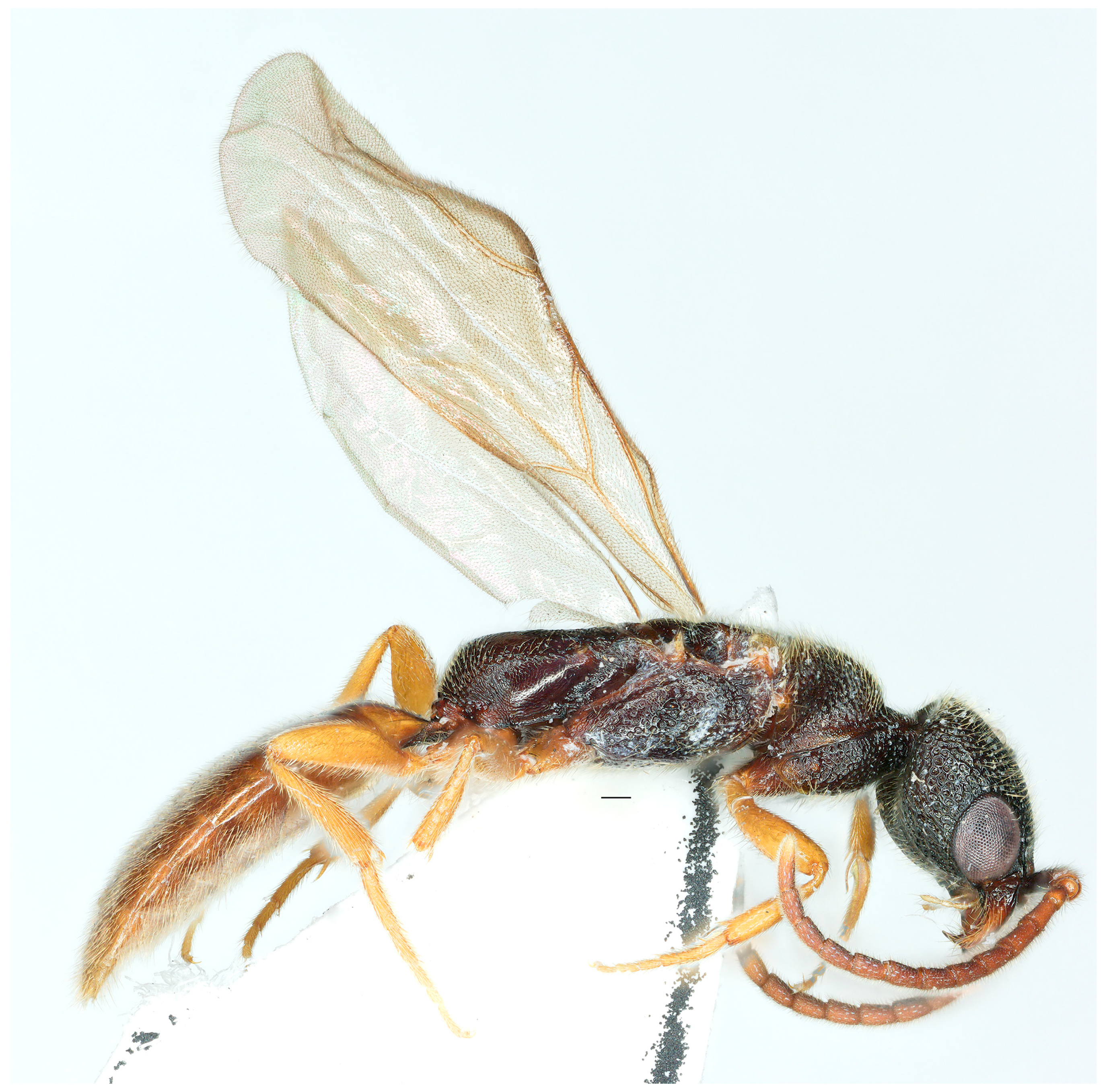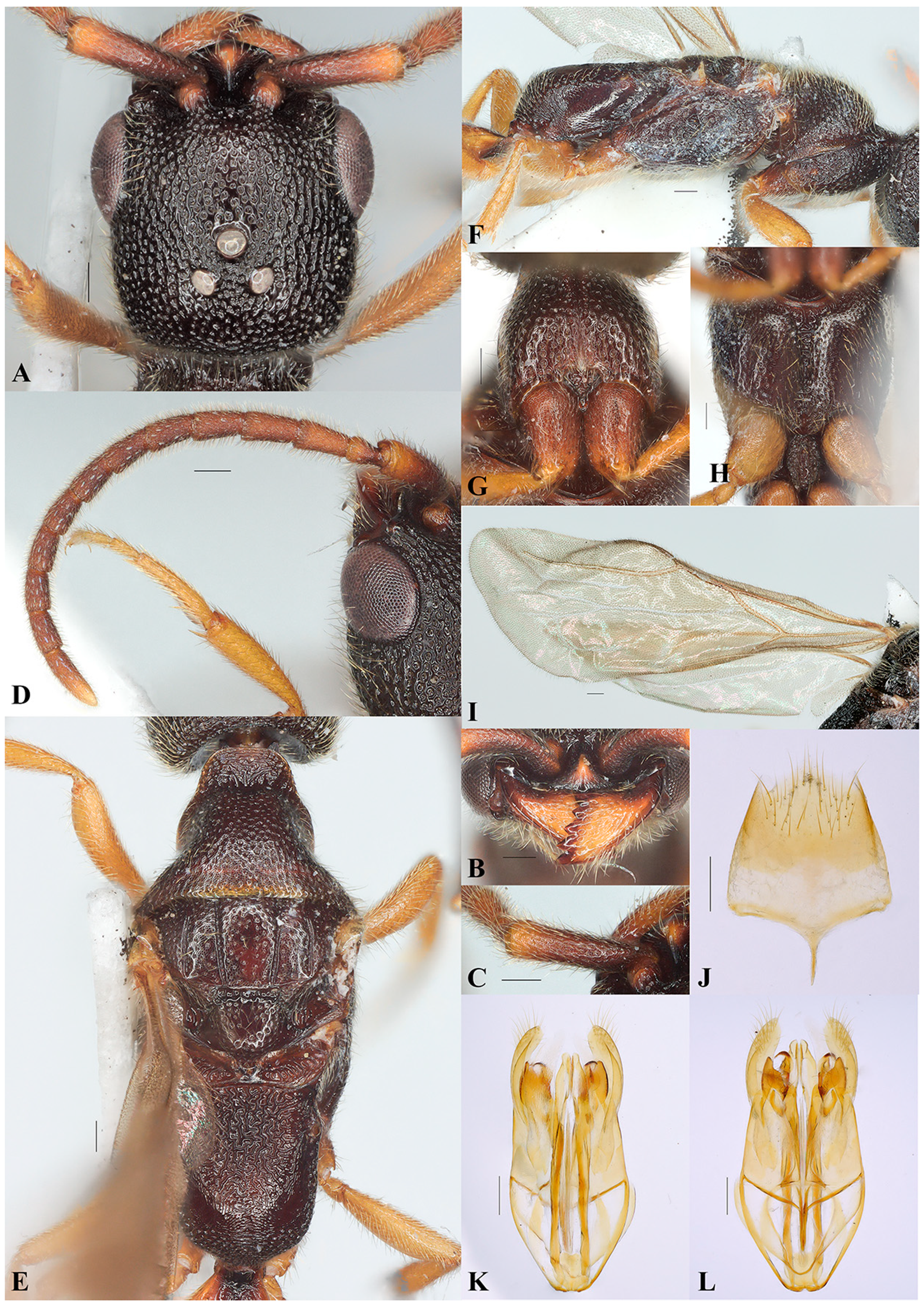First Record of Caloapenesia (Hymenoptera, Bethylidae) from China with Description of One New Species †
Simple Summary
Abstract
1. Introduction
2. Materials and Methods
2.1. Specimens
2.2. Preparation for Morphological Study
3. Results
3.1. Taxomomy
3.2. Description of New Species


- 1.
- Pedicel more than 0.75 × flagellomere I..........................................................................2
- −
- Pedicel less than 0.6 × flagellomere I..............................................................................8
- 2.
- Flagellomeres short, less than 0.35 × scape....................................................................3
- −
- Flagellomeres median-sized, more than 0.35 × scape...................................................4
- 3.
- Metapectal-propodeal disc without metapostnotal-propodeal carina; hypopygeal median lobe convex; hypopygeal lateral lobe angulate; anterolateral apodeme spiniform......................................................................C. inyara
- −
- Metapectal-propodeal disc with conspicuous metapostnotal-propodeal carina; hypopygeal median lobe subangulate; hypopygeal lateral lobe outcurved and very short; anterolateral apodeme rectangular...............................................C. rikawa
- 4.
- Ocelli small, less than 0.18 × WF.....................................................................................5
- −
- Ocelli large, more than 0.23 × WF...................................................................................7
- 5.
- Metapectal-propodeal disc with conspicuous metapostnotal-propodeal carina...........................................................................................................................................6
- −
- Metapectal-propodeal disc with metapostnotal-propodeal carina inconspicuous...................................................................................................................................C. lani
- 6.
- Hypopygium strongly trilobate with median lobe rounded..............................C. diba
- −
- Hypopygium slightly trilobate with median lobe angulate..........................C. jailuna
- 7.
- Median clypeal lobe rounded; occipital carina not visible in dorsal view; head black; mesosoma dark castaneous...................................................................C. leptata
- −
- Median clypeal lobe angulate; occipital carina visible in dorsal view; head and mesosoma testaceous.............................................................................C. philippinensis
- 8.
- Ocelli small, less than 0.18 × WF....................................................................................9
- −
- Ocelli large, more than 0.23 × WF................................................................................18
- 9.
- Median clypeal lobe trapezoidal..................................................................................10
- −
- Median clypeal lobe rounded or subrectangular.......................................................11
- 10.
- Corners of median clypeal lobe angulate; occipital carina complete and visible in dorsal view; hypopygium strongly trilobate, without anterolateral apodeme.............................................................................................................C. launeci
- −
- Corners of median clypeal lobe rounded; occipital carina ill defined; hypopygium slightly trilobate, with anterolateral apodeme rectangular......C. edas
- 11.
- Median clypeal lobe subrectangular..........................................................................12
- −
- Median clypeal lobe rounded......................................................................................13
- 12.
- Flagellomere I less than 1.5 × as long as wide; occipital carina not visible in dorsal view; metapectal-propodeal disc with metapostnotal-propodeal carina conspicuous.......................................................................................................C. mugra
- −
- Flagellomere I more than 2.0 × as long as wide; occipital carina visible in dorsal view; metapectal-propodeal disc without metapostnotal-propodeal carina........................................................................................................................................C. nadaili
- 13.
- Pedicel distinctly short, 0.27 × flagellomere I; dorsalmost tooth of mandible sharp.....................................................................................................................C. brevis
- −
- Pedicel nearly 0.6 × flagellomere I; dorsalmost tooth rounded or blunt.............14
- 14.
- Head longer than wide, LH at least 1.10 × WH..........................................................15
- −
- Head as long as wide.....................................................................................................16
- 15.
- Sides of head posterior to eyes converging posterad; median clypeal lobe without yellow patch; median area of mesoscutellum polished, not punctate; lateral margin of hypopygium outcurved; dorsal harpe as wide as ventral harpe.......................................................................................................................C. heira
- −
- Sides of head posterior to eyes nearly parallel; median clypeal lobe with yellow patch medially; median area of mesoscutellum punctate; lateral margin of hypopygium straight; dorsal harpe narrower than ventral harpe................................................................................................................................C. xui sp. nov.
- 16.
- Occipital carina without ventral projection................................................................17
- −
- Occipital carina with ventral projection.........................................................C. paruwa
- 17.
- Hypopygeal posterior margin slightly trilobate; anterolateral apodeme absent..............................................................................................................................C. arbeni
- −
- Hypopygeal posterior margin strongly trilobate; anterolateral apodeme conspicuous and spiniform...................................................................................C. ana
- 18.
- Eye median-sized, WF 1.15–1.35 × HE.........................................................................19
- −
- Eye very large, WF less than 1.10 × HE..............................................................C. supra
- 19.
- Hypopygeal posterior margin strongly trilobate...................................C. thailandiana
- −
- Hypopygeal posterior margin straight with median lobe angulate........C. sabeli
4. Discussion
Author Contributions
Funding
Data Availability Statement
Acknowledgments
Conflicts of Interest
Abbreviations
| AOL | width between anterior and posterior ocellus, measured as minimum length in frontal view |
| LH | length of head, measured in antero-dorsal view, from apex of clypeus to vertex |
| OOL | shortest distance from a posterior ocellus to nearest eye margin |
| WF | width of frons, measured in antero-dorsal view, its minimum width |
| WH | width of frons, measured in antero-dorsal view, its minimum width |
| WOT | width of ocellar triangle, measured in antero-dorsal view, maximum width including ocelli |
| DPV | distance between posterior ocelli and vertex crest in antero-dorsal view |
References
- Terayama, M. Caloapenesia and Neoapenesia, New Genera of the Family Bethylidae (Hymenoptera, Chrysidoidea) from the Oriental Region, with Proposals of Two New Synonymies of Genera. Jpn. J. Entomol. 1995, 63, 881. [Google Scholar]
- Azevedo, C.O. A New Species of Caloapenesia from Vietnam, with Discovery of the Female of the Genus. Spixiana 2004, 27, 143–146. [Google Scholar]
- Gobbi, F.T.; Azevedo, C.O. Revision of Caloapenesia (Hymenoptera, Bethylidae), with Description of Sixteen New Species. Zootaxa 2014, 3860, 501. [Google Scholar] [CrossRef] [PubMed]
- Martinelli, A.B.; Waichert, C.; Barbosa, D.N.; Fagundes, V.; Azevedo, C.O. The Use of Proteinase K to Access Genitalia Morphology, Vouchering and DNA Extraction in Minute Wasps. An. Acad. Bras. Ciênc. 2017, 89, 1629–1633. [Google Scholar] [CrossRef] [PubMed][Green Version]
- Lanes, G.O.; Kawada, R.; Azevedo, C.O.; Brothers, D.J. Revisited Morphology Applied for Systematics of Flat Wasps (Hymenoptera, Bethylidae). Zootaxa 2020, 4752, 1–127. [Google Scholar] [CrossRef] [PubMed]
- Brito, C.D.D.; Lanes, G.D.O.; Azevedo, C.O. Morphology and Evolution of the Mesopleuron in Bethylidae (Hymenoptera: Chrysidoidea) Mapped on a Molecular Phylogeny. Arthropod Struct. Dev. 2022, 71, 101214. [Google Scholar] [CrossRef] [PubMed]
- Alencar, I.D.C.C.; Waichert, C.; Azevedo, C.O. Opening Pandora’s Box of Pristocerinae: Molecular and Morphological Phylogenies of Apenesia (Hymenoptera, Bethylidae) Reveal Several Hidden Genera. Syst. Entomol. 2018, 43, 481–509. [Google Scholar] [CrossRef]
- Santos, B.F.; Colombo, W.D.; Murray, E.A.; Brady, S.G.; Azevedo, C.O. Insights from the First Phylogenomic Analysis of Flat Wasps (Hymenoptera, Bethylidae) Reveal Two New Subfamilies. Cladistics 2024, 40, 510–525. [Google Scholar] [CrossRef] [PubMed]
Disclaimer/Publisher’s Note: The statements, opinions and data contained in all publications are solely those of the individual author(s) and contributor(s) and not of MDPI and/or the editor(s). MDPI and/or the editor(s) disclaim responsibility for any injury to people or property resulting from any ideas, methods, instructions or products referred to in the content. |
© 2025 by the authors. Licensee MDPI, Basel, Switzerland. This article is an open access article distributed under the terms and conditions of the Creative Commons Attribution (CC BY) license (https://creativecommons.org/licenses/by/4.0/).
Share and Cite
Wang, C.; He, J.; Azevedo, C.O.; Chen, X. First Record of Caloapenesia (Hymenoptera, Bethylidae) from China with Description of One New Species. Insects 2025, 16, 451. https://doi.org/10.3390/insects16050451
Wang C, He J, Azevedo CO, Chen X. First Record of Caloapenesia (Hymenoptera, Bethylidae) from China with Description of One New Species. Insects. 2025; 16(5):451. https://doi.org/10.3390/insects16050451
Chicago/Turabian StyleWang, Chunhong, Junhua He, Celso O. Azevedo, and Xuexin Chen. 2025. "First Record of Caloapenesia (Hymenoptera, Bethylidae) from China with Description of One New Species" Insects 16, no. 5: 451. https://doi.org/10.3390/insects16050451
APA StyleWang, C., He, J., Azevedo, C. O., & Chen, X. (2025). First Record of Caloapenesia (Hymenoptera, Bethylidae) from China with Description of One New Species. Insects, 16(5), 451. https://doi.org/10.3390/insects16050451






